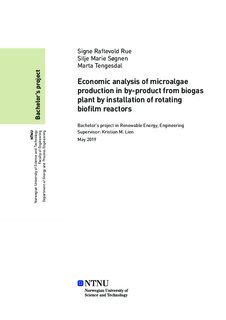| dc.contributor.advisor | Lien, Kristian M. | |
| dc.contributor.author | Rue, Signe Raftevold | |
| dc.contributor.author | Søgnen, Silje Marie | |
| dc.contributor.author | Tengesdal, Marta | |
| dc.date.accessioned | 2019-06-30T14:00:23Z | |
| dc.date.available | 2019-06-30T14:00:23Z | |
| dc.date.issued | 2019 | |
| dc.identifier.uri | http://hdl.handle.net/11250/2602894 | |
| dc.description.abstract | Interessen for dyrking av mikroalger er voksende, og bruksområdene er mange. Mikroalger har høy vekstrate og høyt lipidinnhold, derav essensielle omega–3 fettsyrer og høyverdipigmenter. Det er et økende behov for nye bærekraftige ingredienser til fiskefôr for oppdrettsfisk. Siden alger er en naturlig del av kostholdet til fisk, har de potensiale til å erstatte nåværende ingredienser i oppdrettsfôret. Biogassproduksjonen til Biokraft AS i Trøndelag danner et biprodukt som er rikt på nitrogen og fosfor. Disse næringsstoffene er essensielle for mikroalgevekst, og vil sammen med tilgjengelig CO2 fra biogassproduksjonen gjøre det mulig å gro mikroalger. For å vurdere mulighetene for mikroalgeproduskjon, ble det utført en økonomisk analyse av to ulike scenarioer. Begge scenarioene baserte seg på produksjon fra April til September, med et utgangspunkt i et produksjonsareal på 1 ha, samt bruk av roterende biofilmreaktorer. Scenario 1 så på muligheten av å bruke Phaeodactylum tricornutum-pasta som en ingrediens i fiskefôr. Scenario 2 vurderte muligheten for dyrking av Haematococcus pluvialis, for å ekstrahere det verdifulle pigmentet astaxanthin. I tillegg ga dette scenarioet et interessant restprodukt, med gunstig næringsinnhold. Resultatene fra analysen viste at den halvårlige produksjonen av algepasta og astaxanthin kan bli henholdsvis 57.5 t og 1.4 t, på tørrvektbasis (DW). Produksjonskostnaden for pastaen ble regnet ut til˚a bli 84 NOK kg−1 DW, og vil bli lønnsom dersom den blir solgt for en høyere pris enn 180 NOK kg−1 DW. Dette er en høy pris å konkurrere med som en bulkingrediens til fiskefôr, men kan ha potensiale som tilsetningsstoff i fôr. Den ekstraherte astaxanthinen ble regnet til å få en produksjonskostnad på 4,155 NOK kg−1 DW, som er nesten halvparten av den syntetiske produksjonskostnaden på 8,100 NOK kg−1 DW. Astaxanthinen må bli solgt for en pris over 4,800 NOK kg−1 DW for å være lønnsom. Dette er en klar fordel, siden den nåværende markedsprisen ligger på 20,000–57,000 NOK kg−1 DW. Dette viser et spennende potensiale som ligger til rette for å produsere naturlig astaxanthin i Trøndelag. Analysen viste at investeringen av mikroalgeproduksjonsanlegget vil være lønnsom dersom algene blir solgt som et høyverdiprodukt. | |
| dc.description.abstract | The interest for microalgae cultivation is growing, and the fields of applications are numerous. Microalgae have high growth rate and high lipid content including essential omega–3 fatty acids and high value pigments. There is a growing demand for new sustainable fish feed ingredients in the aquaculture. As algae is a part of the natural fish diet, it has a potential to replace current ingredients in the aquaculturefeed. The biogas production at Biokraft AS in Trøndelag, Norway, creates a by-product which is rich in nitrogen and phosphorus. These nutrients are essential for microalgal growth, and will together with the accessible CO2 from the biogas production enable microalgae cultivation. By conducting a profit and loss (P&L) analysis, two different scenarios were analyzed to determine the profitability of investing in a microalgae production plant. Both scenarios were based on a productionfrom April to September, an area of 1 ha and using rotating biofilm reactors. Scenario 1 was based on using algae paste of Phaeodactylum tricornutumas an omega–3 rich ingredient in fish feed. Scenario 2 was based on cultivation of Haematococcus pluvialis to extract the high value pigment astaxanthin. Inaddition, this scenario gave a remaining defatted biomass, consisting of valuable nutrients.The results from the analysis showed that the semi annual production for algae paste and astaxanthin could be 57.5 t and 1.4 t of dry weight (DW), respectively. The production cost of the paste was calculated to be 84 NOK kg−1 DW, and would be profitable if sold at a price higher than 180 NOK kg−1DW. This is too high a price to compete as a bulk ingredient in fish feed, but might be a potential feed supplement. The extracted astaxanthin was calculated to have a production cost of 4,155 NOK kg−1DW, which is almost half the production cost of synthetic astaxanthin at 8,100 NOK kg−1DW. The astaxanthin should be sold at a price higher than 4,800 NOK kg−1 to be profitable. This is a great advantage as the current market price is at 20,000–57,000 NOK kg−1. This enables the great potential of producing natural astaxanthin in Trøndelag. The analysis showed that the investment of the microalgae production plant will be profitable if the algae is sold as a high value product. | |
| dc.language | eng | |
| dc.publisher | NTNU | |
| dc.title | Økonomisk analyse av mikroalgeproduksjon i biprodukt fra biogassanlegg ved installasjon av roterende biofilmreaktorer | |
| dc.type | Bachelor thesis | |
